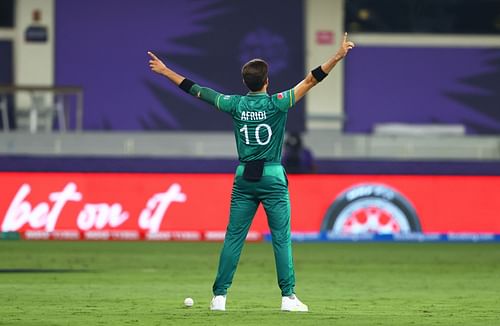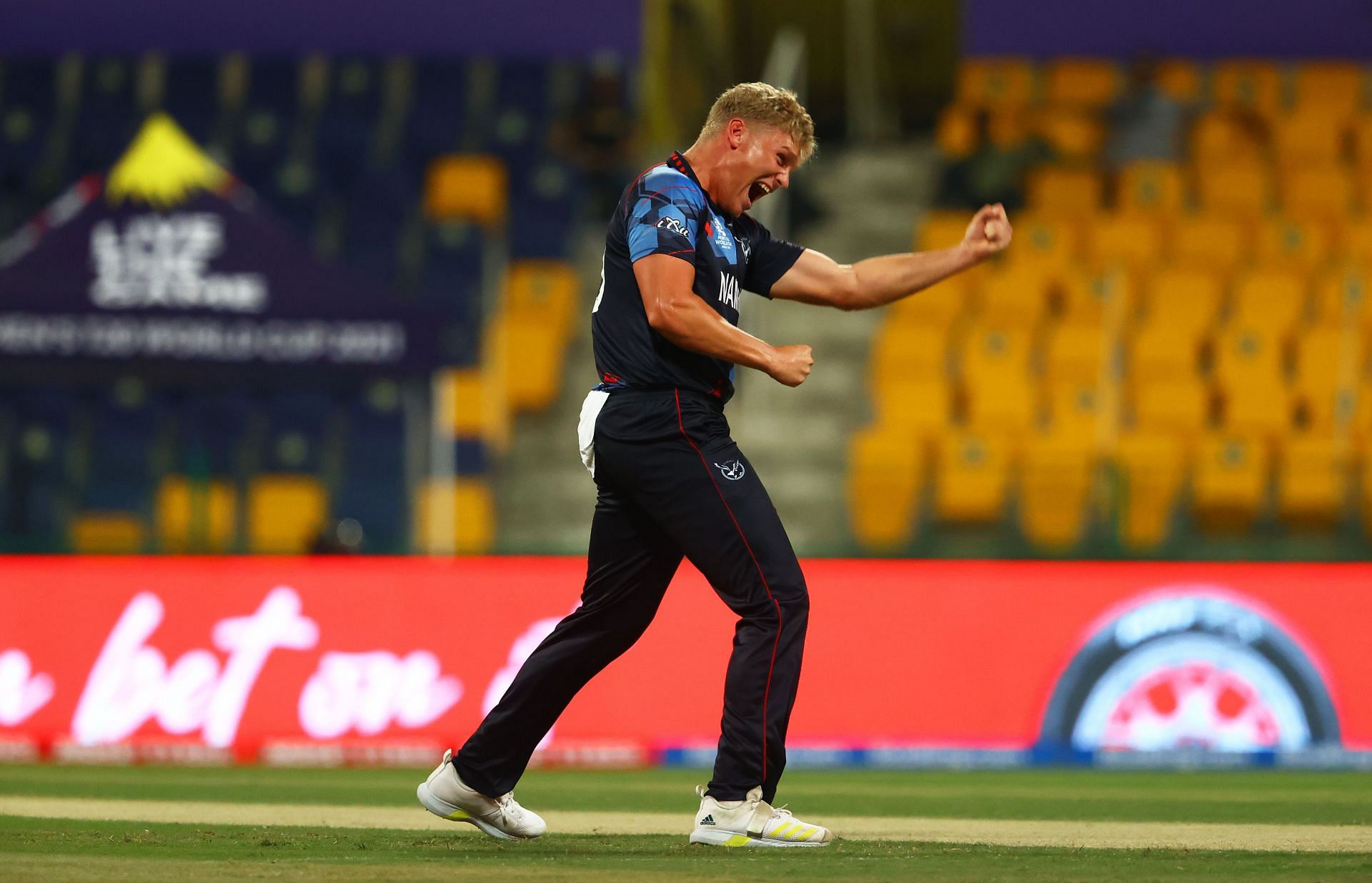
T20 World Cup 2021: Left is right this time round

24th October 2021, Dubai, India and Pakistan are on a collision course at the T20 World Cup. The game, which has only had a stage to itself in ICC events lately, is the fixture the entire world is waiting for. The landscape is adorned with countless batting stars, meaning that bowlers are expected to scramble for every single they concede and are expected to hustle for every wicket.
Then, a tall lanky left-arm pacer marks out his run-up with purpose. He tells the umpire that he is going to bowl over the wicket, takes in a deep breath, comes to grips with the enormity of the situation and then tells himself it is just another game.
The first ball he bowls is slanted across the batter slightly. KL Rahul comes forward and defends. The next ball shapes into Rahul a touch. And the next goes straight, with the batter turning it into the leg side to get off the mark.
So far, Rahul and Rohit Sharma, who has been watching intently from the other end, seem to understand what they are up against. They’ve seen the odd ball seam and another swing, although nothing to make them question why they are opening the batting for India in the T20 World Cup.
Catch the latest ICC T20 World Cup live score here on Sportskeeda!
Then, Shaheen Shah Afridi, while whistling with the wind, unfurls a devilish in-swinging yorker – one Rohit simply has no answer for. He is trapped well in front and Shaheen does his customary celebration. Till a ball ago, it seemed that Rohit had figured things out. But it became clear that he didn’t.
In the 3rd over, Shaheen repeated the dose – this time, completely flummoxing Rahul, who up until that point, had seemed relatively composed at the crease. Again, it seemed that Rahul, despite knowing what he was up against, didn’t quite know what to do when the question was asked.
After another set of shattered stumps, though, he perhaps understood why facing left-arm fast-bowling is perhaps the most difficult task in the world, especially when they are of Shaheen’s caliber.
In that game itself, Shaheen picked up another wicket, namely that of Virat Kohli. On this occasion, he used the angle superbly and dug the ball into the track. The Indian skipper, who was looking to access the leg side, only managed a thick outside edge that floated through to Mohammad Rizwan.
Prima facie, the inclination might be to say that the Indians struggled due to Shaheen’s brilliance. While there is a lot of truth to that particular argument, the fact remains that left-arm seamers across the T20 World Cup have looked incredibly penetrative.
So much so that they’ve seemed likely to take a wicket every time they’ve bowled in the T20 World Cup. And, have, of course, made the average cricket enthusiast also jump of their seats at different junctures of the T20 World Cup.
There are a few reasons why left-arm fast bowlers have enjoyed so much success in the T20 World Cup.
Left-arm seamers have been excellent at the T20 World Cup
With the new ball, their ability to move the ball both ways has left countless batters circumspect. However, it isn’t just the movement that has tied batters in knots. Instead, it is their novel angle and the propensity to shape the ball into right-handed batters, just when they think the ball is sliding away, that has complicated matters.

Not only does that muddle with the batters’ footwork, it makes them extremely tentative, for they don’t know which deliveries to play at. A perfect example would be Calum MacLeod’s dismissal against Namibia’s Ruben Trumpelmann in Match 21 of the T20 World Cup.
Trumpelmann, when he castled George Munsey, swung the ball away from the left-handed batter. Unsurprisingly, MacLeod expected the ball to move in a similar direction when Trumpelmann pitched it on off stump. This time, though, the ball continued with the angle and induced an outside edge.
It might not have been something that Trumpelmann had planned in advance. It might even have been natural variation. But that, in a nutshell is the beauty of left-arm fast bowling – you simply don’t know what to expect.
Apart from that, the angle left-arm fast bowlers generate has been useful towards the end at this year’s T20 World Cup. Jan Frylinck, in particular, has driven that point home and is, as things stand, the fifth highest-wicket taker at the 2021 T20 World Cup.
In essence, the left-arm pacers, owing to their adaptability of bowling over and around the wicket, create new angles. For example, if a right-handed batter is strong on the leg-side, they can slant the ball away and take that side out of the equation. Similarly, if that batter is looking to make room and play through the off-side, these bowlers can tuck him/her up.
Tymal Mills produced an exhibition in that regard against Bangladesh, whereas he wasn’t too shabby against the West Indies as well, with his brand of cutters and hard lengths proving difficult to tackle at the 2021 T20 World Cup.

Additionally, a lot of venues at the T20 World Cup have skewed boundary dimensions – the ideal example being the T20 World Cup game between Bangladesh and Sri Lanka. In such scenarios, it seems easier for left-arm pacers, courtesy of their angle to take one side of the ground out of play.
Through the middle overs, too, left-arm pacers keep posing different quandaries to what batters are usually accustomed to, makes them a more potent alternative.
The fact that most top-drawer batters seem to have a weakness against left-arm pace only makes that notion stronger – something that has already been witnessed at the T20 World Cup.
Kane Williamson, Kohli and Rohit, by the way, average 29.6, 23.81 and 23.85, respectively against left-arm pace in T20 cricket since 2019. Kohli and Rohit have already been dismissed by that variety at the T20 World Cup. Rahul’s average, meanwhile is much better (45.85). But he only strikes at 119.33 – a sharp dip from his overall strike rate of 136.44 between 2019-2021.
Moreover, right-handed batters are still in relative vogue, despite the influx of left-handed batters at the T20 World Cup. In turn, it means that left-arm pacers would always be in the game – just a touch more than their right-arm counterparts.
In fact, most teams at the T20 World Cup have taken that on board and seem to have a left-arm fast bowler capable of making a difference. Interestingly enough, the only team yet to pick a wicket at the T20 World Cup is India – an outfit that doesn’t have a left-arm seamer at its disposal.
While that is, in no way hinting that India might not get a wicket throughout the T20 World Cup, it just illustrates that the Men In Blue might’ve been better off had they had a decent left-arm option at the T20 World Cup.
In contrast, England and Pakistan – sides that have looked utterly dominant, have had Mills and Shaheen pick up the bulk of wickets. Most tellingly, they’ve not allowed any opposition at the T20 World Cup to score more than 151 so far.
Maybe, it means that left is right at the 2021 T20 World Cup. And that performances such as the one Shaheen produced against India might no longer be the exception, irrespective of whether they understand what they are up against or not. These left-arm pacers can be that good.